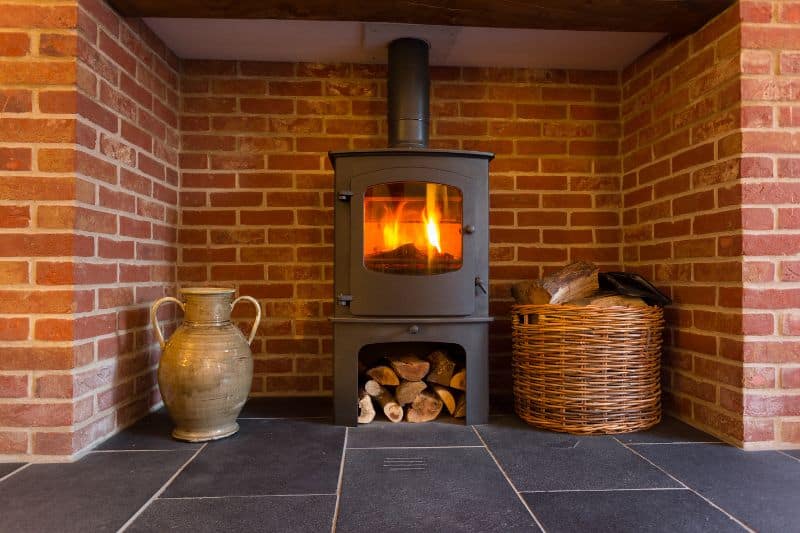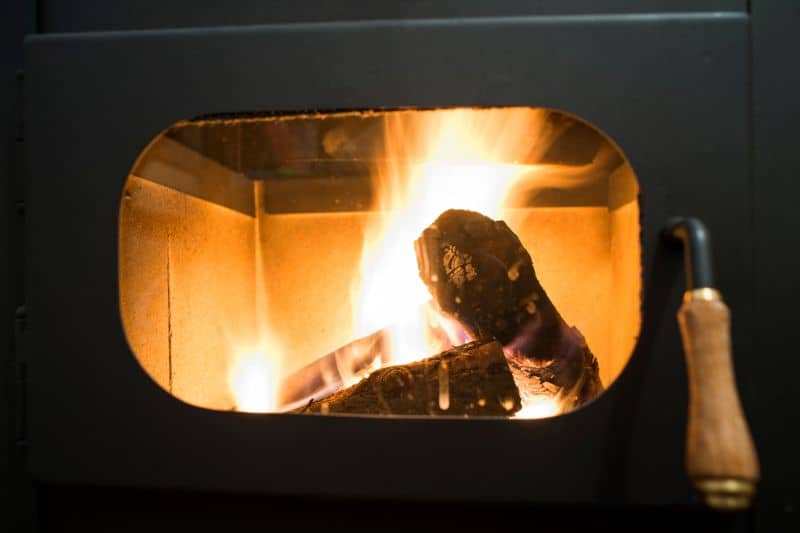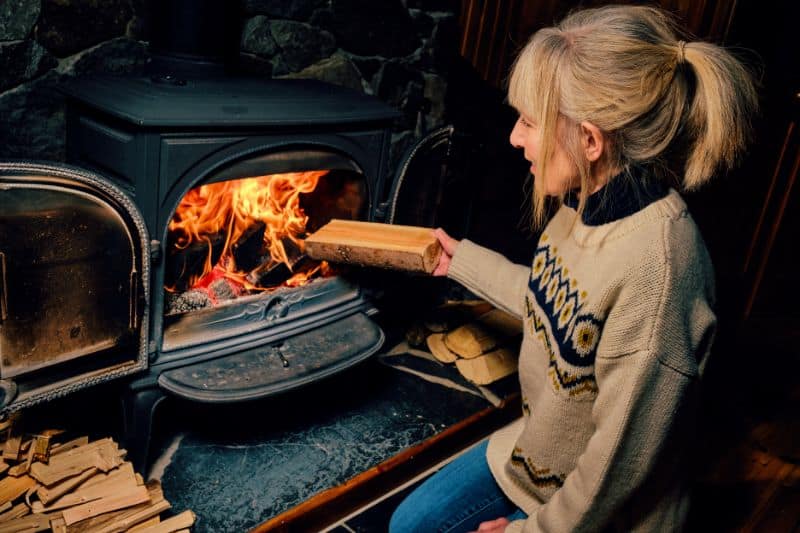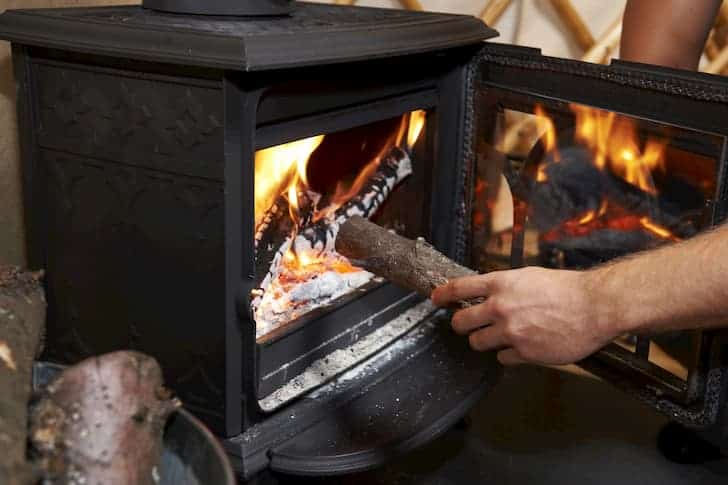Wood-burning stoves are commonly known as wood burners, log burners, or simply wood-burning stoves and are an essential addition to the home.
The appliance is used to heat and warm the home by burning wood or wood-derived biomass, such as sawdust bricks. They produce more heat for the home than an open wood-burning fireplace as they are designed to burn wood more efficiently.
However, how do these appliances fair vis-à-vis the environment? Here are some of the details.
Are Wood-burning Stoves Really Bad for the Environment?
The answer to whether wood-burning stoves are bad for the environment can be either yes or no, depending on how you choose to view the whole scenario. But generally, they are much better than most heating options used at home.
On the positive side of the debate, wood stoves are virtually carbon neutral. You see, these stoves burn wood, which is a carbon-neutral energy source. And although it may seem counter-intuitive, the logic is pretty simple.
You see, throughout its life cycle, a tree absorbs a significant amount of carbon dioxide. So, when the wood is burned in a stove, the absorbed carbon is released back into the atmosphere.
This amount of absorbed carbon dioxide during the lifetime of the tree is balanced by the overall amount of gas released when the wood is burned. Therefore, at the end of it all, the carbon dioxide added to the atmosphere is zero.
And now on the flip side, since wood burning produces carbon dioxide and smoke, we can effectively still argue that wood stoves can cause pollution, and so they can be bad for the environment.
Wood burning in London, for instance, accounted for up to 31% of the city’s particulate pollution a few years back, an increase of 10%.
The particulate matter contributes to climate change and can cause breathing problems or even human cancer.
In fact, specs of soot 100 times smaller than the diameter of a human hair are some of the most harmful kinds of air pollution, and once they enter the body through the lungs, they could exacerbate heart and respiratory conditions and are potentially very dangerous.
Wood-burning stoves are, therefore, not the greenest choice, especially in urban settings.

Are Wood Stoves Environmentally Friendly?
Well, the answer is sometimes. The primary issue on the eco-friendliness of wood-burning stoves is that it is not a clear-cut topic!
To have a clearer answer, you must weigh between the carbon neutrality of burning wood versus their emissions. Whether wood-burning stoves are eco-friendly depends mainly on which one you choose, where, and how you use them.
1. If You Are in An Urban Location
Wood stoves may not be environmentally friendly in urban settings due to several factors. Firstly, acquiring wood for fuel often involves purchasing or importing it, which can increase carbon emissions associated with transportation.
Additionally, the carbon dioxide emitted by the wood stove may not be offset by sufficient tree cover in urban areas, thereby negating its carbon-neutral potential.
The optimal location for installing a wood stove in an eco-friendly manner is in rural or countryside areas. In these settings, access to locally sourced wood is typically easier, reducing transportation-related emissions.
Furthermore, the surrounding natural environment can absorb the carbon dioxide emissions more effectively, aligning with the stove’s potential for carbon neutrality.
2. The Size of Your Room
You should install an efficient model that carefully matches the room’s dimensions. A more miniature wood stove will underperform, and a big one will produce excess heat, making it harmful to the environment.
A stove proportional to the room’s size is properly effective and will be environmentally friendly if we have to factor in the aspect of performance.
3. How Long You Run Them
Wood stoves should not be running all night and day, even in the most rural places. Remember, continued use lowers the effectiveness of the entire appliance and could bring about carbon monoxide leaks if not properly managed. The eco-friendliness of a wood stove is the fact that it provides heat without damaging the environment.
Overusing it will provide excess heat and more emissions than the environment can handle. They should be used to warm the home temporarily, and if the place is warm enough, it should be switched off or not turned on.
4. If It Is Well-Maintained
A well-maintained wood stove is eco-friendly and will perform as it should. If it is not maintained, for instance, if the ash is not removed or if the chimney is not cleaned, you run the risk of having the wood not burning, the chimney releasing smoke inside the house, or the release of soot that is dangerous to human health and the environment in general.

Are Wood Stoves Efficient?
Wood stoves are efficient, and burning wood is almost carbon neutral. A good quality stove is about 80% efficient, with others putting the higher heating value (HHV) at 83%.
This means that 80% of the heat from the stove is used to heat the room. The remaining 20% is lost mainly through the heat rising up the chimney.
In fact, we can safely argue that a wood stove is vastly efficient, seeing that an open fire has an efficiency rate of around 32% and a room open gas effect fire has in the region of 55% efficiency.
A wood-burning stove is, therefore, an excellent choice for heating a home, whether it is just for heating a home’s air or, better still, if you wish to use it for heating the air and water.
Do Wood Stoves Pollute the Air?
Yes, and No! As already stated, wood stoves are carbon neutral, meaning the carbon dioxide released from burning wood is equivalent to what the tree absorbs when growing. It is literally giving back the carbon dioxide it used up, and no additional carbon dioxide is released into the atmosphere.
Also, a wood-burning stove is designed to burn at much higher temperatures, meaning the gases present in the smoke are fully burned and not released back into the atmosphere, resulting in a thermal efficacy of around 80%.
On the flip side, the appliance still emits carbon dioxide into the air. Carbon dioxide is a greenhouse gas and is majorly responsible for contributing to global warming and climate change.
Wood-burning stoves also produce extra doses of particles into the air. In fact, a wood-burning stove emits more particles per hour than a modern diesel lorry.
In addition, under some conditions, wood-burning stoves can contribute to indoor concentrations of carbon monoxide, nitric oxide, nitrogen dioxide, and suspended particles, including benzo-A-pyrene. These are all dangerous elements to human health as well as the environment.
Are Wood-Burning Stoves Bad for Human Health?
Wood-burning stoves are not bad for human health, but depending on several factors, they could be. On one hand, they provide warmth for the home and are incredibly valuable during those cold nights. Secondly, they are carbon neutral and do not release any extra carbon dioxide into the environment.
On the other hand, they produce smoke and fumes that can result in coughing and shortness of breath within a few hours and even minutes of exposure to the fumes. Recurrent exposure can exacerbate many illnesses, such as emphysema and heart failure.
The American Lung Association adds that wood-burning stoves produce harmful toxins that can damage your lungs and increase the risk of cancer, heart disease, and premature death.
As such, one should limit exposure to these stoves and their fumes and always adhere to safety precautions whenever used. As long as wood stoves are properly used and with moderation, chances of them putting human health at risk are very minimal.
Tips for Improving Your Environmental Footprint with A Wood Burner
As seen, how you use your wood stove can determine whether it will be good or bad for your health and the environment.
To help you reap the positives when dodging the negatives, here are some tips for using wood stoves:

1. Only Open the Door to Refuel
As soon as you open your stove door while a fire is burning, the gust of air that follows affects the burning of the logs, leading to a higher rate of pollution. To avoid this, ensure you only open the wood burner’s door when you are refueling. If you are not, leave it closed and let it do its magic
2. Do Not Overfill Your Log Burner
Overfilling the log burner with logs limits the supply and circulation of air in the burner, meaning your fuel will not burn as efficiently. To avoid wasting energy or not attaining the desired results, feed the burner with fuel enough to burn well and refill only when needed
3. Get the Proper Wood
Always use properly dried and seasoned wood for your appliance. If you do not have it, get some from your local supplier. Not every old piece of wood is safe for the environment, as burning some could mean releasing more toxins into the environment than needed.
At the same time, get the adequately dried wood to avoid the emission of too much carbon monoxide as well as smoke.
The smoke and moisture create a build-up of creosote in your flue, clogging your flue and could quickly turn into a fire hazard if not properly maintained. Seasoned wood has been cut and dried under cover for at least 6-12 months and registers less than 20% moisture with a meter.
4. Maintain Your Entire System
Make sure the stove is always clean. A dirty stove is a polluting stove and could do more harm to the environment than needed.
Also, ensure the chimney is properly insulated or install a chimney liner. This can help improve the chimney’s draw, aid efficiency, and help you stay protected against dangerous carbon monoxide leaks.
A well-maintained wood-burning system will produce the desired results and release as minimal negative effects as possible.
And, of course, install smoke and carbon monoxide alarms and have them properly maintained so that you are notified immediately of a smoke or carbon monoxide leak.
Finally, be sure to have your system inspected by a certified inspector after cleaning the fireplace and chimney, which should be done at least once per year.
5. Dispose of Your Burnt Logs and Clear the Ash from The Fireplace
Disposing of your burnt logs outside is important as the ashes can emit carbon monoxide, which is very dangerous. Therefore, remove them from your home as soon as possible and dispose of them properly.
Cleaning the ash from the fireplace whenever it reaches the bottom of the grate helps a lot, as if left uncleared, the ash will impede airflow, hampering the overall performance of the wood burner.
6. Burn Hardwoods, and Not Softwoods
Hardwoods like oak, ash, and maple are denser and heavier than lighter softwoods like pine, poplar, and cedar. As such, the hardwood delivers more heat for the home than softwoods.
7. Install Them in The Countryside Areas
As already determined, wood stove burners are not ideal for an urban setting. This is because burning wood releases the carbon dioxide the tree used up when growing, making the appliance carbon neutral. However, urban settings are not characterized by their abundance of trees to absorb the released carbon dioxide.
In the countryside, however, the released carbon dioxide will be absorbed by other trees, making the process safe for the environment.
Additionally, the emissions from wood burning boiler stoves are cleaner than oil or gas-burning boilers in the countryside areas.
Another reason for advocating for wood stoves in rural areas is the availability of wood in the burners. In an urban setting, you must buy or import such wood from elsewhere.






